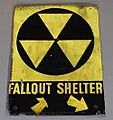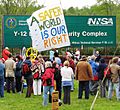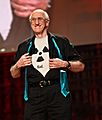Anti-nuclear movement in the United States facts for kids
The anti-nuclear movement in the United States is a group of people and organizations who have worked to stop the building of new nuclear power plants and to reduce the use of nuclear weapons. For many years, this movement has successfully delayed or stopped plans for some nuclear power plants.
Important anti-nuclear campaigns in the 1970s caught the attention of the whole country. These included protests at the Calvert Cliffs Nuclear Power Plant, Seabrook Station Nuclear Power Plant, Diablo Canyon Power Plant, Shoreham Nuclear Power Plant, and after the Three Mile Island accident. More recently, groups have focused on places like the Indian Point Energy Center and the proposed Yucca Mountain nuclear waste repository. Many different groups have joined protests and demonstrations over the years.
Contents
Who are the Anti-Nuclear Groups?
More than eighty anti-nuclear groups have worked in the United States. Some well-known groups include the Abalone Alliance, Clamshell Alliance, Greenpeace USA, and the Sierra Club. Other groups are the Institute for Energy and Environmental Research, Musicians United for Safe Energy, and the Nuclear Information and Resource Service.
When Did Protests Happen?
Anti-nuclear protests were strongest in the 1970s and 1980s. This movement grew out of the larger environmental movement. Big protests happened at nuclear sites like Calvert Cliffs, Seabrook, Diablo Canyon, Shoreham, and Three Mile Island.
In the 1980s, many anti-nuclear activists started focusing on the nuclear freeze movement. This movement wanted to stop the creation of more nuclear weapons. The main concern about nuclear dangers in the USA changed from power plants to the risk of nuclear war.
On June 12, 1982, one million people gathered in Central Park in New York City. They protested against nuclear weapons and wanted to end the Cold War arms race. This was the largest anti-nuclear protest and the biggest political demonstration in American history.
More protests for nuclear disarmament happened on June 20, 1983, at 50 places across the United States. The Nevada Desert Experience held many protests and peace camps at the Nevada Test Site during the 1980s and 1990s.
What Are Recent Campaigns About?
Recent campaigns by anti-nuclear groups have focused on several nuclear power plants. These include the Enrico Fermi Nuclear Power Plant, Indian Point Energy Center, and Vermont Yankee Nuclear Power Plant. There have also been campaigns about the Y-12 Nuclear Weapons Plant, the Idaho National Laboratory, and the Lawrence Livermore National Laboratory.
Which Scientists Oppose Nuclear Power?
Some scientists and engineers have shared concerns about nuclear power. These include Barry Commoner, John Gofman, Amory Lovins, and Arjun Makhijani. Scientists who have spoken out against nuclear weapons include Linus Pauling and Frank N. von Hippel.
Images for kids
-
A sign pointing to an old fallout shelter in New York City.
-
This view of downtown Las Vegas shows a mushroom cloud in the background. Scenes such as this were typical during the 1950s. From 1951 to 1962 the government conducted 100 atmospheric tests at the nearby Nevada Test Site.
-
President Jimmy Carter leaving Three Mile Island for Middletown, Pennsylvania, April 1, 1979
-
April 2011 OREPA rally at the Y-12 nuclear weapons plant entrance
-
Following the 2011 Japanese Fukushima nuclear disaster, authorities shut down the nation's 54 nuclear power plants. As of 2013, the Fukushima site remains highly radioactive, with some 160,000 evacuees still living in temporary housing, and some land will be unfarmable for centuries. The difficult cleanup job will take 40 or more years, and cost tens of billions of dollars.
See also
 In Spanish: Movimiento antinuclear en Estados Unidos para niños
In Spanish: Movimiento antinuclear en Estados Unidos para niños













